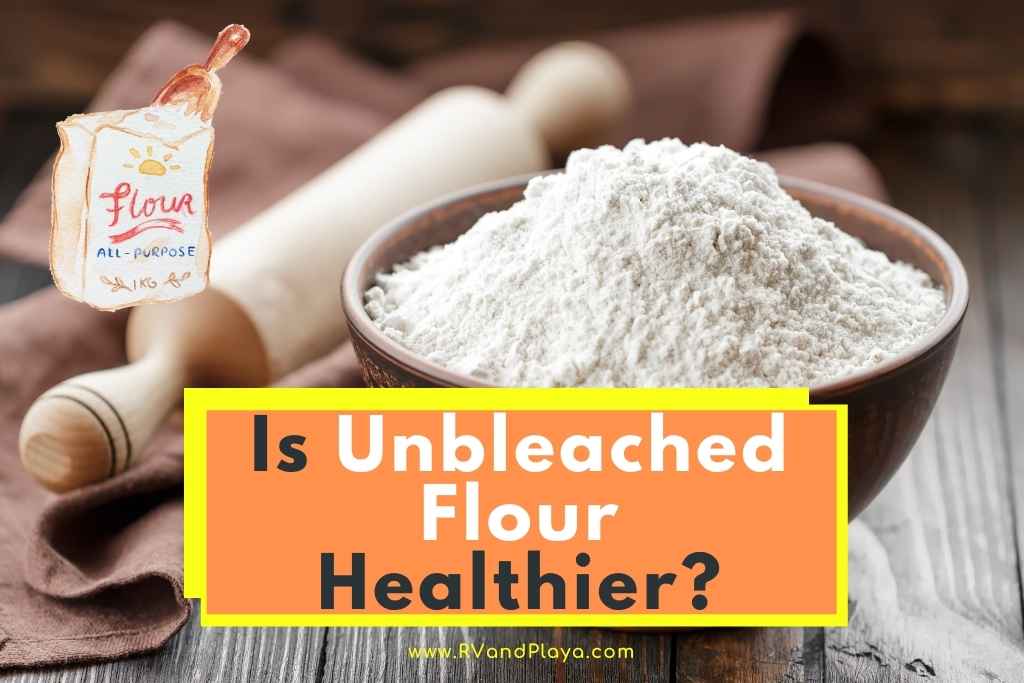People ask, is unbleached flour healthier, or what is the difference between bleached and unbleached flour?
Choosing between unbleached and bleached flour is a decision left to personal preference, with many people quick to assume that unbleached flour is a safer option for your health than bleached, but is this actually true?
Unbleached and bleached flour actually have nearly identical nutritional values and are both popular options in the baking community. However, bleached flour does go through a chemical process that its counterpart does not, making unbleached flour a little safer to consume.
Although unbleached flour doesn’t go through an intense chemical process to whiten the powder and ultimately destroy key nutrients, it isn’t as healthy as many people may think.
In this article, we will be discussing the difference between the two flours and try to determine which option is healthier.
Table of Contents
Is Unbleached Flour Healthier for You?
You may have read about the possible dangers of bleached flour and how the chemicals used to speed up the aging process can be harmful to your health; however, have you considered the facts surrounding these accusations, and do you know whether or not they are actually true?
In order to determine which flour option is the better choice, we should first distinguish what each flour is and how it is made, then compare the benefits of both (or lack thereof).
Read also: Who Makes Great Value Flour? (Walmart Products)
How They Are Processed
One of the biggest differences between bleached flour vs. unbleached is the way in which it is processed before being packaged.
While both flours are milled, bleached flour is refined; this indicates that the nutrient-rich parts of the grain have been removed, taking its health benefits with it.
Unbleached can be made from refined or unrefined flour, giving it a chance of having a little more vitamins and nutrients included (especially if it is made from whole wheat).
After the mill process, bleached flour goes through a chemical process to speed up aging by using benzoyl peroxide, potassium bromate, or chlorine.
This process helps to increase the white color and changes the texture and taste of the final product.
Unbleached flour ages naturally, taking quite a bit longer to be ready for packaging than bleached, which is why bleached flour has become a popular thing.
Taste and Appearance
As mentioned above, the bleaching process will whiten the flour, giving it a much nicer look, often making it more appealing to consumers, and providing a much finer grain. While unbleached flour has a more off-white, darker color and a thicker, more coarse texture.
Despite the difference in characteristics, both flours taste pretty similar, with very few people having the ability to tell the difference between one or the other.
What They are Used For
Due to its finer texture, bleached flour is more frequently used to bake things like cookies, pancakes, and pie crusts because of its ability to absorb liquid quickly and effectively.
Unbleached flour is a great option to use for thicker doughs such as bread and pastries or anything that needs a thickness to hold its shape.
Nutritional Value
When it comes to nutrition, both fours contain nearly the same amount of vitamins and other nutrients, despite the chemical process bleached flour goes through. Both of these products have a nearly identical caloric value, fat, protein, and fiber content.
So, if you are trying to choose between one option or the other for something like weight loss, there really isn’t much of a difference.
In all actuality, anyone trying to lose weight should actually consider refraining from eating either option altogether. In these cases, whole wheat, unrefined, enriched flour will provide you with the best results.
One area in which unbleached flour may show potential signs of being a healthier option is the chemical process bleached flour goes through. The chemicals used during this time may not be ideal for healthy human consumption.
Benzoyl peroxide is one chemical used to bleach flour; while this product is great for cleaning out cuts or as a topical skincare item, it might be harmful to your natural anti-oxidants (according to some animal studies.)
Another chemical found in bleached flour is potassium bromate. Potassium bromate is an additive that strengthens dough and helps it rise higher in the over.
It is also very controversial when it comes to different studies, with many of them linking this chemical to certain drugs and possible kidney damage. (again, only found in animal studies.)
On the other hand, Unbleached flour doesn’t go through any altering processes with no chemicals added to its creation, possibly making it better for consumption.
Shelf Life for Both Options
Unbleached flour has a much longer shelf life than unbleached flour; when sitting in proper packaging at room temperature away from moisture, this flour can last for up to eight months; longer if it is stored in the freezer.
Bleached flour’s shelf life is only 3-6 months at the most while lasting a few months longer when stored in the refrigerator or freezer.
Bleached vs. Unbleached Flour: A Quick Overview
Here is a quick comparison of both products side-by-side to give you a better understanding of the information and details for both options.
| Unbleached Flour | Bleached Flour |
|---|---|
| Dark or off white | white |
| Has a thick or grainy texture | Has a fine, powdery texture |
| Used in foods where the dough needs to be thicker | Used to bake foods with tons of moisture |
| Calories 120, Carbs 25g, Protein 4g, Fiber 1g | Calories 110g, Carbs 22g, Protein 3g, Fiber 1g |
| Processed with chemicals | Processed naturally |
The Final Verdict
Although bleached flour is processed with chemicals and those chemicals might diminish a few of the nutrients. It isn’t proven anywhere that the chemicals have any harmful effects on humans, and with similar nutritional values and uses, it isn’t proven that one is any healthier than the other.
If you want to stay away from anything altered by chemicals and additives, it would be best for you to stick with unbleached flour products.
If you want a flour product that is healthy for you, it’s best to stay away from both and stick with whole grains.
Here are some of my favorite services, products, and Stores
There are affiliate links, so if you do decide to use any of them, I´ll earn a small commission. But in all honesty, these are the exact what I use and recommend to everyone, even my own family.
To see all my of most up-to-date recommendations, check out this resource that I made for you!
+ Products & Services
+ Convenience Stores
+ Save Thousands of Dollars
References
https://www.healthline.com/nutrition/bleached-vs-unbleached-flour
https://healthresearchfunding.org/bleached-versus-unbleached-flour/
Recent Posts
Have you ever asked yourself or your friend who produces or makes Great Value cereal or cereal bars for Walmart? Well, you are at the perfect place to find the answer to such a question. Great...
Do you know who makes Great Value flour for Walmart? this is one of the questions our readers ask a lot. Well, we´ve got you covered. Great Value is Walmart's signature brand of products....


